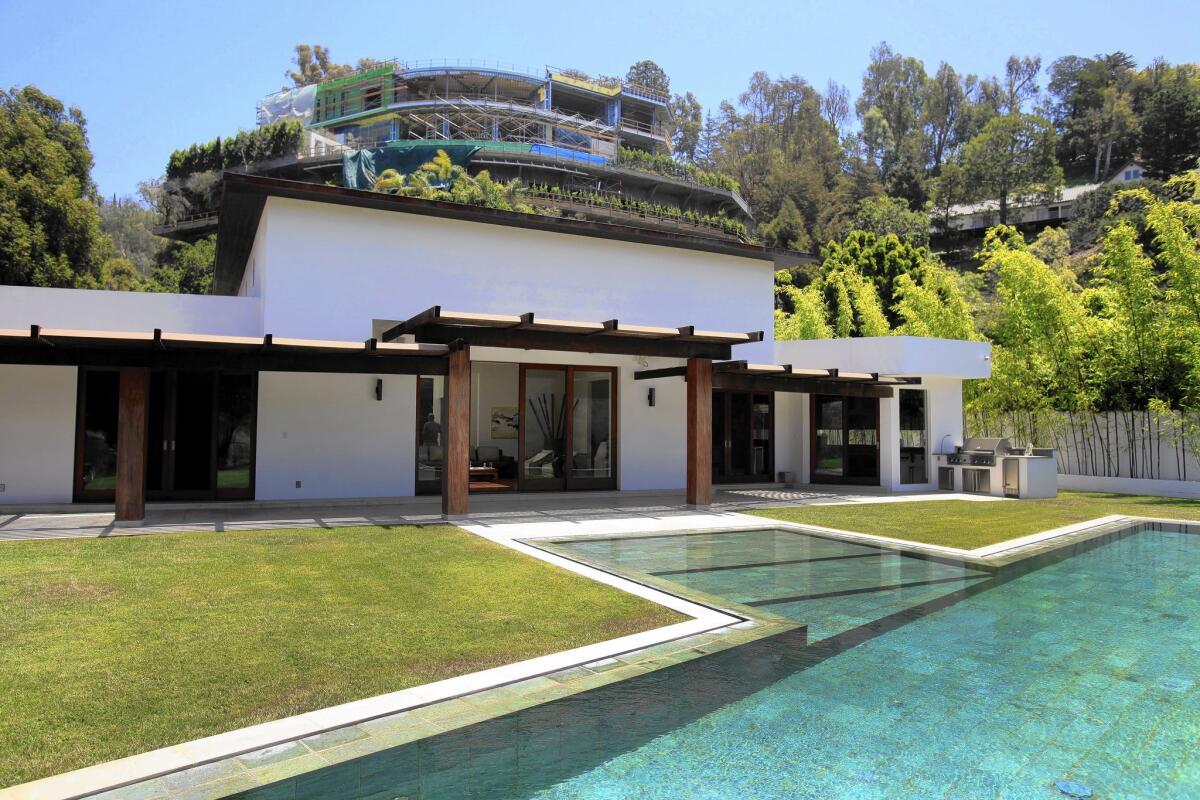Building huge hillside homes — and steep resentment — in Bel-Air

- Share via
When Joseph Horacek III looks at the “Starship Enterprise” — as he calls the mansion going up above his low-slung, Balinese-inspired contemporary in Bel-Air — visual pollution isn’t his primary concern.
The veteran entertainment attorney is afraid the whole thing will come sliding down the hill and crush his household.
With post-recession construction booming on the Westside, architects are building up and under: creating wine cellars and subterranean bowling alleys, altering slopes and ridgelines.
Convoys of dirt haulers and cement mixers compete with residents for space on the narrow roads winding through Bel-Air and Trousdale Estates. Some of the vehicles have sheared tree branches, crumpled utility boxes and toppled stop signs. Atop those more mundane problems, homeowners worry that there is a real risk their hillsides are being destabilized.
“No one is protecting our community,” said Fred Rosen, former chief executive of Ticketmaster and co-founder of the Bel Air Homeowners Alliance, which wants the city of Los Angeles to impose stricter limits on construction.
When building codes were implemented, no one anticipated the enormous residential projects in the hills, Rosen said. Planners and engineers could not have envisioned the need for caisson foundations and vast retaining walls.
“We have 2014 technology with 1980 regulations,” Rosen said. “They approve sites on top of each other, without understanding the consequences and collateral damage for the neighborhood.
“You can buy a 3,000-square-foot house, regrade the lot and make a 35,000- to 40,000-square-foot house,” he said.
Robert Steinbach, chief of the Los Angeles Department of Building and Safety’s inspection bureau, said the agency works to minimize construction-related traffic and disruptions. But summer is prime season for builders.
“Right now you’re talking about a nuisance issue because people see and hear idling trucks and they worry about fire and rescue vehicles,” he said. “But if they do [the construction work] in the rainy season, you’re talking about really dangerous effects.
“So it’s the lesser of the evils.”
Building officials say their role is to make sure that properties are built safely, but they also note that city codes allow construction of huge homes, even in hillside areas.
Residents became more vocal about their concerns after separate but eerily similar accidents earlier this year that killed two Los Angeles police officers on steep Loma Vista Drive in Beverly Hills’ Trousdale Estates.
After the second incident, in which an out-of-control cement truck struck an off-duty detective’s pickup, Beverly Hills imposed a 30-day moratorium on haulers weighing more than three tons. Contractors now are required to have the vehicles inspected by police, and they may travel to and from job sites only on pre-approved routes.
Beverly Hills’ City Council also stopped new grading on hillside properties until tighter construction rules could be put into place.
Los Angeles, Rosen said, has been slower to react to the construction-related perils.
Until recently, he and fellow crusaders, including actor Leonard Nimoy and director William Friedkin, had saved their harshest criticism for Los Angeles Councilman Paul Koretz, saying he had ignored the ramifications of a “construction bombardment.”
Koretz countered that he has worked closely with the Bel-Air Assn., a longtime neighborhood group that in July wrote him a letter of support.
“We’re aware of a new problem that never existed anywhere in the city,” Koretz said. “We’re looking at legislative fixes. … We have to get more of a handle.”
On July 30, he introduced two motions to strengthen the city’s hillside ordinance, which was implemented in 2011 to rein in some of the more daring slope-side building. One would potentially limit exemptions for developers seeking to grade hillsides and require more robust notification of neighbors. The other would be aimed at developing more proactive inspections and enforcement of building and haul route rules.
According to a consultant Horacek hired, the multilevel “starship” project on Strada Vecchia is at least 61 feet tall, 25 feet above the maximum. (The size, at 30,000 square feet or so, is not that outlandish by today’s standards, Horacek acknowledged. A home going up nearby is thought to be more than 85,000 square feet.) He said chunks of the hillside outside his front door already have cascaded onto his street.
In an appeal filed with Los Angeles, Horacek contended that developer Mohamed Hadid had unlawfully demolished the existing house, had not obtained appropriate permits for the residence he is building on spec and had improperly altered the hill’s topography.
Last month, Koretz sent a letter to city officials saying in part: “It is hard to believe that a project that looks more like the Getty Center than a home could have been built without a single discretionary entitlement or public input — not even a mere haul route.”
Building officials then ordered Hadid to stop construction and told him they intended to revoke his permits because of multiple violations. The matter remains under investigation.
Benjamin Reznik, Hadid’s attorney, said a surveyor has filed revised topographical and grading documents with the city and that the project “is within the legal limits.”
Hadid, who has appeared on “Shahs of Sunset” and “The Real Housewives of Beverly Hills,” said in an interview that the trend toward larger homes would end up benefiting the city by expanding its tax rolls.
“It might not be good for the neighbors for a little bit,” Hadid said, “but values go up.”
[email protected]
Twitter: @MarthaGroves
[email protected]
Twitter: @JosephSerna
More to Read
Sign up for Essential California
The most important California stories and recommendations in your inbox every morning.
You may occasionally receive promotional content from the Los Angeles Times.












